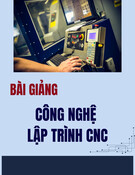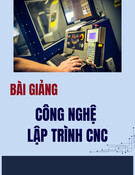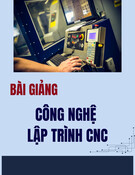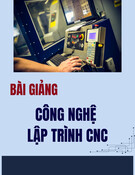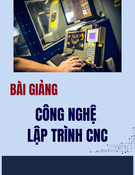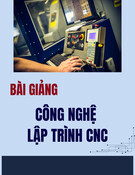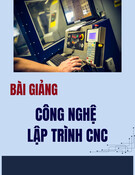
44 Vu Quoc Huy
EFFICIENCY ENHANCEMENT OF PHOTOVOLTAIC SOLAR CELL SYSTEM
USING PHASE CHANGE MATERIAL (PCM)
Vu Quoc Huy*
School of Technology, Van Lang University, Ho Chi Minh City, Vietnam
*Corresponding author: huy.vu@vlu.edu.vn
(Received: September 14, 2024; Revised: September 27, 2024; Accepted: October 05, 2024)
DOI: 10.31130/ud-jst.2024.519E
Abstract – Electrical efficiency of photovoltaic (PV) solar cell is
reduced significantly with the increase of its temperature. Cooling
down the PV solar cell is essential to maintain the electrical
performance and lifetime of the PV module. In the present study,
cooling of PV module using a paraffin-based phase change
material (PCM) in hot climate of Vietnam is investigated.
Thermal modelling is first validated against experimental data
reported in literature and then transient thermal simulations are
carried out for a duration of 24 hours to assess the effect of PCM
itself and PCM with internal fins. Results indicate that the peak
temperature of the PV cell can be reduced by 4.3 K thanks to the
PV-PCM system with PCM of 40 mm thickness and up to 10 K
if the system is integrated with two cooling internal fins.
Key words – Solar energy; Photovoltaic cell; Phase change
material (PCM); PV cooling; Electrical efficiency
1. Introduction
Solar energy is largely considered as a natural
sustainable source to replace fossil fuels as well to reduce
carbon dioxide emission. It is well known that only a small
percentage (15 - 20%) of incident solar energy on a
photovoltaic (PV) solar cell can be converted to electricity
while the remaining solar energy generates heat and raises
the temperature of the PV cell that affects to its efficiency
[1]. In average, the efficiency of PV solar cell reduces by
0.45% for each degree of temperature rise compared to the
ideal reference working temperature of 25oC. Furthermore,
overheating results in thermal stress which is harmful to the
lifetime of PV systems. To reduce the PV module
temperature, several cooling methods are reported in
literature which can be classified as active cooling, passive
cooling and phase change material (PCM) cooling [12].
Phase change material cooling has received a great interest
of researchers in recent years thanks to its easy installation
(no fluids or extra power systems are required) and thus it
is convenient for various engineering applications (solar
energy, electronic cooling, building cooling…) [15].
Huang et al. [2] conducted several experiments for PCM
container without and with internal fins to observe the
melting process of PCM under constant insolation. The
effect of inclination angle on natural convection of PCM
during melting process was investigated by Kamkari et al.
[6]. Dealing with a full system of PV-PCM, various
thermal models have been proposed for solving
concurrently the heat transfer problem and the solid –
liquid phase transition of PCM [3, 4, 8]. Kaplani and
Kaplanis [5] examined the dependence of PV module’s
temperature on its orientation and inclination, wind
velocity and direction and proposed an improved thermal
model describing more accurate the combined natural and
forced convection. Since several factors need to be
monitored to enhance overall efficiency of the PV module,
numerical modelling of full thermal processes exerted on
the PV module plays a pivotal role in parametric analyses.
Energy efficiency of PV system depends strongly on
the weather conditions (solar irradiance, ambient
temperature, wind velocity) of the location, therefore the
choice of appropriate PCM type (paraffin wax RT25,
RT35, RT42…) for cooling is based mainly on the local
ambient temperature [9, 13, 14]. High ambient temperature
conditions in tropical country as Vietnam requires more
attention to the selection of PCM type, it is thus vital to
conduct the study to choose the relevant PCM type in the
local weather conditions. The current study presents a
thermal modelling to assess the effectiveness of PCM in
enhancing the PV solar cell’s efficiency in the hot climate
of Ho Chi Minh City, Vietnam. Thermal modelling is first
validated against experimental data reported by Huang et
al. [2] and then transient thermal simulations are carried
out for a duration of 24 hours to monitor the full melting –
solidification process of PCM as well as the temperature
variation of PV-PCM systems. Effects of PCM itself and
PCM with internal fins are analyzed.
2. Model of PV-PCM system
2.1. Thermal model
A standard photovoltaic (PV) panel consists of five
layers: glass, ethylene-vinyl acetate (EVA) sheet,
polycrystalline silicon solar cells, EVA sheet and TPT
(Tedlar/PET/Tedlar) back-sheet layer. In a typical PV-
PCM system, PCM material is stored in an aluminum box
attached at the back of the PV module (Figure 1).
Figure 1. Physical and thermal model of PV-PCM system
The heat transfer through the PV-PCM system includes
the solar radiation on the glass cover and silicon solar cells,

ISSN 1859-1531 - THE UNIVERSITY OF DANANG - JOURNAL OF SCIENCE AND TECHNOLOGY, VOL. 22, NO. 11B, 2024 45
the convection and radiation at the front and back surfaces
with the surrounding environment, natural convection
within PCM medium and the conduction among different
layers of the system. At the front and back surfaces of the
system, the heat transfer equations are as follows:
−𝑘𝑔𝑙𝑎𝑠𝑠 𝜕𝑇
𝜕𝑦 =ℎ𝑓,𝑐𝑜𝑛𝑣(𝑇𝑎𝑚𝑏 −𝑇𝑔𝑙𝑎𝑠𝑠)
+𝜀𝑔𝑙𝑎𝑠𝑠𝐹𝑓𝑟𝑜𝑛𝑡𝜎(𝑇𝑎𝑚𝑏
4−𝑇𝑔𝑙𝑎𝑠𝑠
4)+𝛼𝑔𝑙𝑎𝑠𝑠𝐺𝑃𝑉(𝑡) (1)
−𝑘𝑎𝑙𝑢𝑚 𝜕𝑇
𝜕𝑦 =ℎ𝑏,𝑐𝑜𝑛𝑣(𝑇𝑎𝑚𝑏 −𝑇𝑎𝑙𝑢𝑚)
+𝜀𝑎𝑙𝑢𝑚𝐹𝑏𝑎𝑐𝑘𝜎(𝑇𝑎𝑚𝑏
4−𝑇𝑎𝑙𝑢𝑚
4) (2)
where hf,conv and hb,conv are respectively the combined heat
transfer coefficients for natural and forced convection for
front glass surface and back aluminum surface, Tamb, Tglass
and Talum are respectively the ambient, front glass surface
and back aluminum surface temperatures. Regarding the
heat radiation exchange, σ is the Stefan-Boltzmann
constant, 𝜀𝑔𝑙𝑎𝑠𝑠 =0.91 and 𝜀𝑎𝑙𝑢𝑚 =0.85 are the
emissivity coefficients of front and back surfaces [5],
Ffront and Fback are the view factors of the front and back
surfaces to sky and ground respectively. The sky and
ground temperatures are assumed to be equal to the
ambient temperature [7]. Solar radiation absorbed by the
glass cover is determined from the glass absorptivity αglass
and the incident solar irradiation on the PV module GPV.
Between the layers within the system, the heat
conduction is governed by:
𝜌𝐶𝑝𝜕𝑇
𝜕𝑡 =𝑘𝜕𝑇
𝜕𝑦 (3)
in which, ρ, Cp, k are respectively the density, specific heat
and thermal conductivity of each layer.
The combined natural and forced convection
coefficients (ℎ𝑐𝑜𝑛𝑣 =ℎ𝑓𝑟𝑒𝑒 +ℎ𝑓𝑜𝑟𝑐𝑒𝑑) for front (hf,conv) and
back (hb,conv) surfaces of the PV-PCM system depend
strongly on the local environment condition where the
system is installed. The natural convection coefficient hfree
may be estimated from the Rayleigh and Prandtl numbers
of the air flow (laminar flow in this case 104≤𝑅𝑎𝐿≤
109) and the characteristic length of the PV panel (Lc):
ℎ𝑓𝑟𝑒𝑒 =𝑘𝑎𝑖𝑟
𝐿𝑐(0.68+0.67𝑅𝑎𝐿
1/4
[1+(0.492/𝑃𝑟)9/16]4/9) (4)
The forced convection due to the wind velocity
(normally below 6 m/s) could also be defined from the
Reynolds and Prandtl numbers (formulation for laminar
flow is shown):
ℎ𝑓𝑜𝑟𝑐𝑒𝑑 =𝑘𝑎𝑖𝑟
𝐿𝑐(0.664𝑅𝑒𝐿
0.5𝑃𝑟1/3) (5)
Naturally, forced convection is always included one
part of natural convection effect. The dominance of
natural or forced convection may be defined based on
the parameter Gr/Re2 of the flow [16]. Natural
convection is negligible when Gr/Re2 < 0.1, forced
convection is negligible when Gr/Re2 > 10 and both
natural and forced convection must be taken into
account when 0.1 < Gr/Re2 < 10.
2.2. Solar irradiation and power generation
Usually, the PV panel system is installed at a tilt angle
(β) from the horizontal surface to maximize the amount of
the receiving solar radiation. The solar irradiation on a
tilted PV panel (GPV) is calculated from the total horizontal
(surface) irradiation (Ghorizontal) as follows:
𝐺𝑃𝑉 =𝐺ℎ𝑜𝑟𝑖𝑧𝑜𝑛𝑡𝑎𝑙cos(𝜃) (6)
where θ is the solar incidence angle. For a true south-facing
tilted PV panel in the northern hemisphere, θ is defined
from the solar declination (δ), the hour angle (h), the local
latitude (L) and the PV tilt angle (β):
cos(𝜃)=sin(𝐿−𝛽)sin(𝛿)
+cos(𝐿−𝛽)cos(𝛿)cos(ℎ) (7)
The view factors Ffront and Fback in the equations (1), (2)
are defined from the tilt angle of the PV panel as follows [5]:
𝐹𝑓𝑟𝑜𝑛𝑡 =(1+𝑐𝑜𝑠𝛽)/2 (8)
𝐹𝑏𝑎𝑐𝑘 =(1−cos(𝜋−𝛽))/2 (9)
The electrical power generated by the PV system (Pe)
is determined from the area of the solar panel (A) and the
solar irradiation on the system (GPV):
𝑃𝑒=𝜂𝑃𝑉𝐴𝐺𝑃𝑉 (10)
The effect of the PV temperature (TPV) on the efficiency
of PV system is described through the electrical efficiency
(𝜂𝑃𝑉) as given below [1]:
𝜂𝑃𝑉 =𝜂𝑟𝑒𝑓[1−0.0045(𝑇𝑃𝑉 −25)+0.1𝑙𝑜𝑔10(𝐺𝑃𝑉/1000)]
(11)
where 𝜂𝑟𝑒𝑓 =15.6% is the reference efficiency of a solar
cell at 25oC and irradiation of 1000 W/m2. The equation of
𝜂𝑃𝑉 corresponds to the fact that the efficiency decreases of
0.45% when the PV temperature increases of 1oC.
2.3. PCM model
PCM acts as a heat sink, absorbing heat generation by
the PV panel during daylight and releasing heat during
night, to cool down the PV panel. During daylight, PCM
receives heat from the PV panel and changes its physical
state from solid to liquid (melting process). Reversely,
solidification process of PCM takes place during night to
bring the PCM back to the initial solid phase. The
temperature dependent density of the PCM can be
described by Boussinesq approximation:
𝜌𝑃𝐶𝑀(𝑇)=𝜌𝑜[1−𝛽𝑃𝐶𝑀(𝑇−𝑇𝑟𝑒𝑓)] (12)
where ρ0 is the reference density (solid phase), βPCM is the
thermal expansion coefficient and Tref is the reference
temperature corresponding to the reference density. The
PCM medium can be considered as a porous medium
(Darcy - Forchheimer model) to model the phase transition
process, in which the energy equation and momentum
equations (Navier-Stokes equations) with the effect of
buoyancy force are solved simultaneously.
3. Numerical models and validation
Transient thermal modelling of the PV-PCM system is
carried out in Altair® SimLab® 2024. First, the numerical
model of PCM melting process is validated against Huang
experimental data for 250 minutes [2]. The experimental

46 Vu Quoc Huy
system had the front and rear walls fabricated from 4.5 mm
thick aluminum plate. PCM RT25 used in the experiment
was stored in a container of 40 mm width, 132 mm height
and 300 mm length. The upper and lower horizontal faces of
the PCM container were insulated. The constant insolation
(a solar simulator) applied to the front aluminum surface was
750 W/m2. The convection heat transfer coefficients on the
front and rear surfaces were assumed to be 12.5 and
7.5 W/m2.K. The ambient temperature is 22oC. Figure 2
shows the configuration of the experimental PCM system.
Figure 2. Heat transfer experiment of PCM system [2]
Figure 3. Experimental and computational temperatures at
the front surface of the verification PCM system
The comparison of experimental and computational
temperatures at the front surface of the system is presented
in Figure 3. The numerical results are in good agreement
with the experimental ones. The average difference
between experimental and numerical results is 0.7oC.
Figure 4 shows the temperature contours in the system
during melting process at different moments (30, 60, 120,
200 minutes). At the beginning of the melting process,
during first 50 minutes, the surface temperature increases
linearly (Figure 3) and the solid-liquid interface inside of
PCM is nearly parallel to the front hot surface (Figure 4a)
illustrating that the heat conduction from the front surface
to the PCM is the dominant mode (sensible heat). During
the periods from 50 – 200 minutes, PCM acts to absorb heat
from the front surface under the form of latent heat to
maintain the temperature of the front surface while
continuing receiving the constant insolation (Figure 3).
During this period, the buoyant force becomes important
that promotes the natural convection and thus the melting
from the top wall of the container (Figures 4b, 4c). After
200 minutes, PCM approaches complete melting meaning
that its capacity of heat absorption reaches the limit.
Accordingly, the front surface temperature resumes to
increase significantly (Figure 3).
a) Time = 30 min b) Time = 60 min
c) Time = 120 min d) Time = 200 min
Figure 4. Temperature contour during melting process
4. Results and discussion
4.1. Weather data and PV-PCM model
For a real local context of Ho Chi Minh city, Vietnam
(10.8276 oN, 106.7 oE) weather data is collected from the
website weatherspark.com and the solar irradiation data is
consulted from the Global Solar Atlas of the World Bank

ISSN 1859-1531 - THE UNIVERSITY OF DANANG - JOURNAL OF SCIENCE AND TECHNOLOGY, VOL. 22, NO. 11B, 2024 47
Group. Since both the average temperature during daytime
and the solar irradiation are highest in February, the data of
February 15th, 2024 is selected for study. Figure 5
represents the collected data of ambient temperature and
surface solar irradiation in 24 hours (GMT +7). The wind
velocity during the day varies from 2 m/s to 5.7 m/s with
the average value of 3.7 m/s. It is worthy noted that since
the wind velocity is instantaneous rather than quasi
continuous as temperature/ solar radiation, the effective
value of wind velocity should be lower than the above-
mentioned value.
Figure 5. Data of ambient temperature and horizontal surface
solar radiation
To assess the performance of an PV-PCM system,
thermal characteristics of the system during a whole day
(24 hours) need to be monitored. In the real configuration
of PV-PCM presented in Figure 1, EVA layer, silicon solar
cell and TPT layer have respectively thin thicknesses of
0.5 mm, 0.2 mm and 0.3 mm. The impact of EVA layer,
TPT layer to the heat transfer of silicon solar cell is very
small and could be negligible. Therefore, in this study, a
single layer of silicon solar cell of 1 mm is used to represent
concurrently the effect of EVA layer and TPT layer. The
simplified five-layer PV-PCM model in this study includes
the glass cover, the silicon solar cell, the front aluminium
plate, the PCM and the back aluminium plate has been
created (Figure 6).
The choice of PCM is based on the range of ambient
temperature. As shown in the Figure 5, the nighttime where
the solidification process of PCM takes place has an
average temperature around 28oC. The solidification
temperature of PCM should be higher than the nighttime
average temperature to ensure that the PCM could release
heat and come back to the initial solid phase before starting
a new daytime. Therefore, RT35HC paraffin wax is
selected for the PCM in this study. Table 1 shows the
properties and thicknesses of layers in the studied PV-PCM
system. Three cases of PCM thickness (30, 40, 50 mm) are
considered to investigate the effect of PCM thickness.
Regarding the length and width of the model, dimensions
of a half solar cell (150 mm x 75 mm) are taken. As
recommended by the Global Solar Atlas, to perform
optimally, the PV-PCM panel is pointed directly to the true
south and the tilt angle from the horizontal surface β = 15o.
Two different system configurations without and with
internal fins are shown in Figure 6.
Table 1. Properties and thickness of PV panel and PCM
Layers
Density
(kg/m3)
Cp
(J/kg.K)
Conductivity
(W/m.K)
Thickness
(mm)
Glass
3000
500
1.8
3
Silicon
cell
2330
677
148
1
Alumi
-nium
2700
900
237
2
RT35
HC
880/770
2000
0.2
30/40/
50
Thermal properties of RT35HC:
Latent heat of fusion (J/kg): 240 000
Phase change temperature (oC): 34 – 36
Solar radiation coming to the PV-PCM system is
absorbed little by the glass cover and transmitted mostly to
the silicon solar cells. The solar cell has low transmissivity,
then the absorption by the layers below the solar cell could
be negligible. Therefore, in this study, only the effects of
solar radiation on the glass cover and on the silicon solar
cell are considered. Table 2 represents the optical
properties of the glass cover and the silicon solar cell used
in the PV-PCM model.
Table 2. Optical properties of PV-PCM model
Layers
Absorptivity
Reflectivity
Transmissivity
Glass
0.05
0
0.95
Silicon
cell
0.9
0.08
0.02
Figure 6. Configurations of PV-PCM systems
4.2. Result of thermal simulations with PCM
All transient thermal simulations are carried out for a
duration of 24 hours, starting from 6 am corresponding to
the moment having the solar radiation. The temporal values
of ambient temperature and surface solar radiation shown
in Figure 5 are used in simulations. To estimate the
combined convection heat transfer coefficients for the front
glass and back aluminum surfaces, an average constant
wind velocity of 2 m/s is assumed and therefore two
convection heat transfer coefficients respectively for the

48 Vu Quoc Huy
front and back surfaces are unchanged during the whole
computation duration. The assumed wind velocity results
in the Rayleigh number in the range of 106 – 107
corresponding to the regime of laminar flow. Accordingly,
the natural convection coefficient hfree and the forced
convection coefficient hforced can be determined by the
equations (4) and (5). Otherwise, the parameter Gr/Re2
falls in the range of 0.01 – 0.02 and therefore the effect of
the forced convection is dominant while the natural
convection is negligible [16].
Figure 7 shows the variations of PV solar cell
temperature during 24 hours for four different models: PV
system without PCM (the reference PV system) and PV-
PCM systems with different thicknesses of PCM (30, 40,
50 mm). For the reference PV system, the model includes
only three layers: glass cover, silicon solar cell and the TPT
back-sheet. The solar cell temperature of the reference
system increases with the solar radiation and reaches a
maximum value around noon. The variation of solar cell
temperature is similar to the variation of solar radiation.
The peak temperature of solar cell is 322.2 K. When solar
radiation is not available from 18h, the solar cell
temperature rapidly decreases to the ambient temperature.
It is noted that although the ambient temperature maintains
its maximum value from 13h to 15h (Figure 5), the solar
cell temperature decreases accordingly with the solar
radiation. The obtained result of solar cell temperature
indicates the role of wind-induced forced convection in
cooling the conventional PV module. This observation is
in agreement with the experimental results reported in the
studies of Hasan et al. [9] and Mohammed et al. [14] in hot
climate conditions.
Regarding the three cases of PV-PCM system, the
effects of PCM to the solar cell temperature are similar
except the peak temperatures and the final temperatures.
When the solar cell temperature rises above the PCM’s
melting temperature (307 K), PCM starts to absorb heat
from the solar cell and thus slows down the temperature
increase of the solar cell. Peak temperatures of solar cells
in PV-PCM systems are lower than the peak temperature
of the reference system. Furthermore, the peak
temperatures in PV-PCM systems are reached later, around
14 o’clock. The advantage of PCM is proven by the
significant drop of solar cell’s peak temperature whereas
the high temperature in the solidification phase of PCM
remains its drawback. This numerical result is in
accordance with the experiments conducted by Hasan et al.
[9]. The peak temperatures are 319 K for the system with
30 mm PCM and 317.9 K for both cases of 40 mm and
50 mm PCM. After the daytime, PCM begins the
solidification process as it releases gradually the heat to the
environment to come back as close as possible to the initial
solid state. However, as shown in Figure 7, the PCM’s
thickness has an important effect on the final temperature
of the solar cell. The final temperatures are respectively
299.2 K, 300.5 K and 302.2 K for the cases of 30 mm,
40 mm and 50 mm PCM. Greater thickness needs longer
time to release the heat. Among the three considered PV-
PCM systems, the case with 40 mm PCM brings the best
effect to the peak temperature (drop of 4.3 K) and the final
temperature of the solar cell.
4.3. Enhancement of PCM effectiveness with fins
Main limitation of PCM is the low thermal conductivity
and thus the PV-PCM system requires long duration to
recover its initial solid state. To improve the PCM thermal
performance, internal fins added inside the PCM container
is a widely adopted solution. As reported in several studies
[10, 11], numerous parameters of the internal fins (length,
thickness, distance…) need to be considered to achieve the
best effectiveness. In this study, due to the small dimension
of the studied model, only two cases with one and two fins
are considered. The PV-PCM system with 40 mm PCM has
been selected for further study with fins. Each added fin
has thickness of 2 mm and length of 40 mm (Figure 6).
Figure 8 shows the comparison of solar cell
temperature during 24h between the reference PV system,
the system of 40 mm PCM without fin and two systems of
40 mm PCM with one fin and two fins. The obtained results
indicate the effectiveness of added fins to enhance the
thermal performance of PCM in decreasing both the peak
temperature and the final temperature of the solar cell. The
peak temperatures are respectively 313.6 K and 312.2 K
for the system with one fin and two fins. Compared to the
reference system, the PV-PCM system with two fins cools
down the solar cell’s peak temperature by 10 K. This
finding shows a great potential of using PV-PCM system
with internal fins to enhance the efficiency of PV solar cell.
Figure 7. Solar cell temperatures in different PV-PCM systems
Figure 8. Effect of internal cooling fins in PV-PCM systems
5. Conclusion
The thermal model of the PV-PCM system including
the solar radiation and three different modes of heat

![Tài liệu đặc tính kỹ thuật dây đồng trần xoắn [C] chuẩn nhất](https://cdn.tailieu.vn/images/document/thumbnail/2025/20250808/trinhvanmotnt@gmail.com/135x160/21161754899208.jpg)

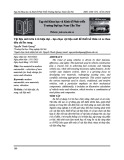
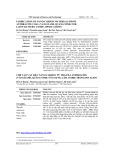


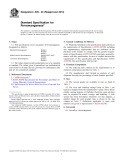
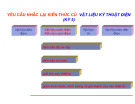

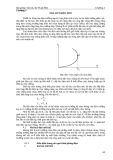
![Bài tập tối ưu trong gia công cắt gọt [kèm lời giải chi tiết]](https://cdn.tailieu.vn/images/document/thumbnail/2025/20251129/dinhd8055/135x160/26351764558606.jpg)




